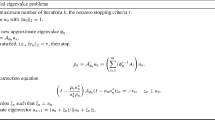Abstract
The paper describes a heuristic algorithm for solving a generalized Hermitian eigenvalue problem fast. The algorithm searches a subspace for an approximate solution of the problem. If the approximate solution is unacceptable, the subspace is expanded to a larger one, and then, in the expanded subspace a possibly better approximated solution is computed. The algorithm iterates these two steps alternately. Thus, the speed of the convergence of the algorithm depends on how to generate a subspace. In this paper, we derive a Riccati equation whose solution can correct the approximate solution of a generalized Hermitian eigenvalue problem to the exact one. In other words, the solution of the eigenvalue problem can be found if a subspace is expanded by the solution of the Riccati equation. This is a feature the existing algorithms such as the Krylov subspace algorithm implemented in the MATLAB and the Jacobi–Davidson algorithm do not have. However, similar to solving the eigenvalue problem, solving the Riccati equation is time-consuming. We consider solving the Riccati equation with low accuracy and use its approximate solution to expand a subspace. The implementation of this heuristic algorithm is discussed so that the computational cost of the algorithm can be saved. Some experimental results show that the heuristic algorithm converges within fewer iterations and thus requires lesser computational time comparing with the existing algorithms.

Similar content being viewed by others
References
Bai Z, Demmel J, Dongarra J, Ruhe A, van der Vorst HA (2000) Templates for the solution of algebraic eigenvalue problems: a practical guide. SIAM, New York
Sleijpen GLG, van der Vorst HA (1996) A Jacobi–Davidson iteration method for linear eigenvalue problems. SIAM J Matrix Anal Appl 17(2):401–425
Fokkema DR, Sleijpen GLG, van der Vorst HA (1998) Jacobi–Davidson style QR and QZ algorithms for the reduction of matrix pencils. SIAM J Sci Comput 20(1):94–125
Vömel C, Tomov SZ, Marques OA, Canning A, Wang LW, Dongarra JJ (2008) State-of-the-art eigensolvers for electronic structure calculations of large scale nano-systems. J Comput Phys 227(15):7113–7124
Bandlow B, Sievers D, Schuhmann R (2010) An improved Jacobi–Davidson method for the computation of selected eigenmodes in waveguide cross sections. IEEE Trans Magn 46(8):3461–3464
Li C, Du Z, Liao P (2015) Computing interarea oscillation modes of large-scale power systems using two-sided Jacobi–Davidson method. IEEE Trans Power Syst 30(6):2946–2954
Huang TM, Lin WW, Wang W (2016) A hybrid Jacobi–Davidson method for interior cluster eigenvalues with large null-space in three dimensional lossless Drude dispersive metallic photonic crystals. Comput Phys Commun 207:221–231
Brandts JH (2003) Solving eigenproblems: from arnoldi via Jacobi–Davidson to the Riccati method. Lect Notes Comput Sci 2542:167–173
Brandts JH (2003) The Riccati algorithm for eigenvalues and invariant subspaces of matrices with inexpensive action. Linear Algebra Appl 358(1–3):335–365
Miyata T (2018) On correction-based iterative methods for eigenvalue problems. IEICE Trans Fundam 10:1668–1675
Francis JGF (1961) The QR transformation: a unitary analogue to the LR transformation, parts I. Comput J 4(3):265–271
Francis JGF (1962) The QR transformation: a unitary analogue to the LR transformation, parts II. Comput J 4(4):332–345
Kublanovskaya VN (1962) On some algorithms for the solution of the complete eigenvalue problem. USSR Comput Math Math Phys 1(3):637–657
Golub GH, Loan CFV (2012) Matrix computations. Johns Hopkins University Press, Baltimore
Moler CB, Stewart GW (1973) An algorithm for generalized matrix eigenvalue problems. SIAM J Numer Anal 10(2):241–256
Paige CC, Saunders MA (1975) Solution of sparse indefinite systems of linear equations. SIAM J Numer Anal 12(4):617–629
van der Vorst HA (2003) Iterative Krylov methods for large linear systems. Cambridge University Press, Cambridge
Davis TA, Hu Y (2011) The university of Florida sparse matrix collection. ACM Trans Math Softw 38(1): 1–25. Available as the SuiteSparse matrix collection (http://www.cise.ufl.edu/research/sparse/matrices/)
Bai Z, Day D, Demmel J, Dongarra J (1997) A test matrix collection for non-Hermitian eigenvalue problems. LAPACK Work Note 123:1–45
Medale M, Cochelin B, Bissen E, Alpy N (2020) A one-dimensional full-range two-phase model to efficiently compute bifurcation diagrams in sub-cooled boiling flows in vertical heated tube. J Comput Phys 404(109131):1–23
Güttel S, Tisseur F (2017) The nonlinear eigenvalue problem. Acta Numer 26:1–94
Tikhov SV, Valovik DV (2019) Maxwell’s equations with arbitrary self-action nonlinearity in a waveguiding theory: guided modes and asymptotic of eigenvalues. J Math Anal Appl 479(1):1138–1157
Acknowledgements
This work was supported by KAKENHI Grant Number 18K11343.
Author information
Authors and Affiliations
Corresponding author
Additional information
Publisher's Note
Springer Nature remains neutral with regard to jurisdictional claims in published maps and institutional affiliations.
Rights and permissions
About this article
Cite this article
Miyata, T. A Riccati-type algorithm for solving generalized Hermitian eigenvalue problems. J Supercomput 77, 2091–2102 (2021). https://doi.org/10.1007/s11227-020-03331-w
Published:
Issue Date:
DOI: https://doi.org/10.1007/s11227-020-03331-w




